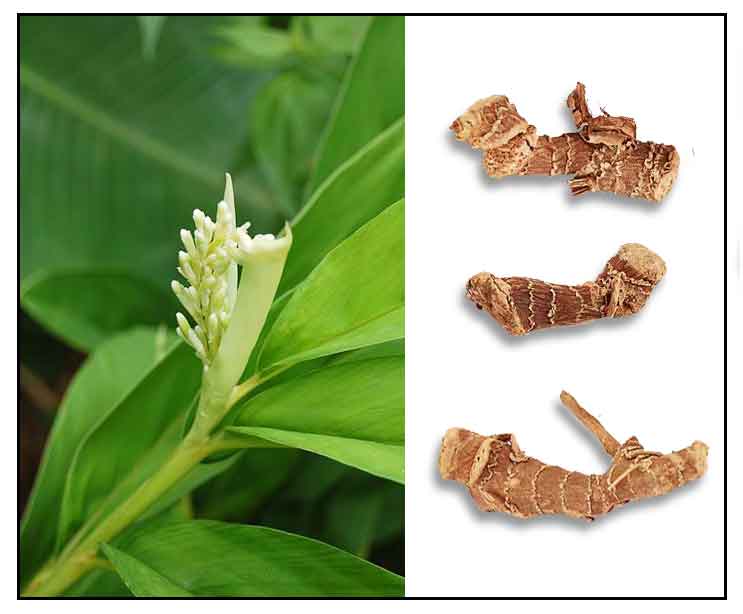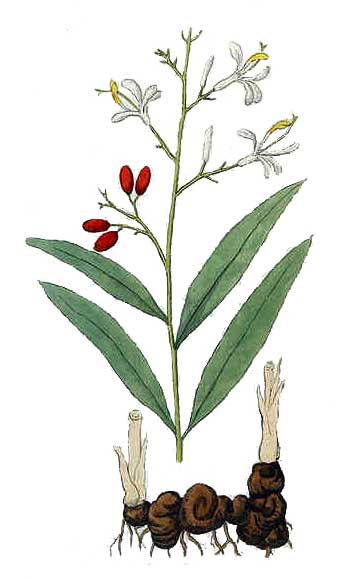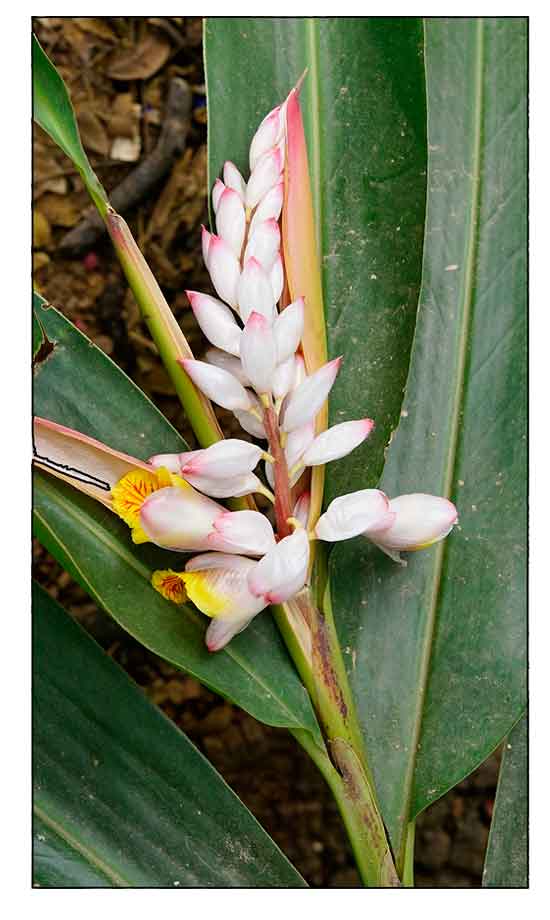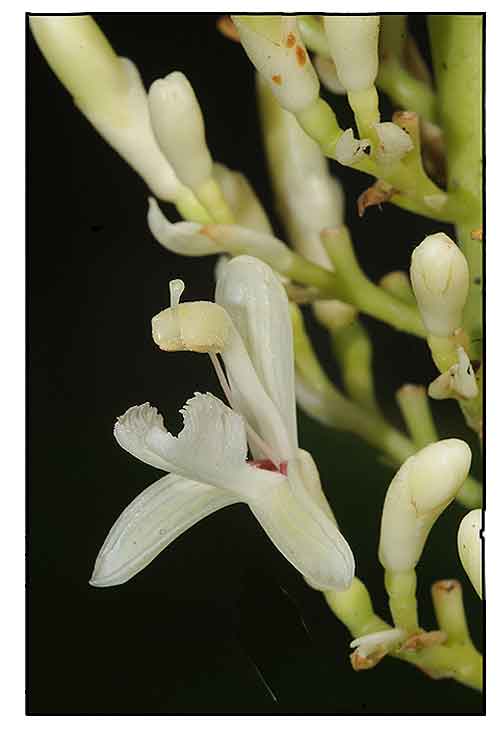
 Gen info Gen info
- Alpinia is a genus of flowering plants in the ginger family, Zingiberaceae. Species are native to Asia, Australia, and the Pacific Islands. Species of the genus are generally known as shell gingers.
- The genus is the largest in the ginger family, with 245 species and 2 hybrids.
- Alpinia galanga is a plant in the ginger family. It bears a rhizome used largely as herb in Unani medicine and as a spice in Arab and Southeast Asian cuisine.
- Etymology: The genus Alpinia was name by the Scottish botanist William Roxburgh in 1810, and named after Prospero Alpini, a 17th century Italian botanist who specialized in exotic plants. (43) The species epithet galanga is from "galangal", probably from Persian qulanjan or Arabic khalanjan, which may be an adaptation of Chinese gao liang jiang. Names in North India derives from the root, including kulanja in Sanskrit, kulanjan in Hindi, and kholinjan in Urdu. (44)
Botany
• Lankauas is a herbaceous plant with strongly aromatic rhizomes. Stems are 1 to 2 meters high, about 2.5 centimeters in diameter. Leaves are pale green, linear lanceolate, alternating, with short hairs beneath, on reedy stems. Inflorescence is pyramid-like, terminal, erect, about 30 centimeters long. Rachis and pedicels are yellowish green. Succulent flowers are cream-colored. Fruits are red berries. Seeds are obtusely angular.
Distribution
- Native to the Philippines.
-
Generally found in old clearings.
- In Rizal, Laguna, Camarines, and Sorsogon Provinces in Luzon; in Leyte; in Lanao and Agusan Provinces in Mindanao; and in Palawan.
- Also native to Assam, Bangladesh, Borneo, Cambodia, China South-Central, China Southeast, Hainan, Jawa, Malaya, Myanmar, Sumatera, Thailand, Vietnam.
 Constituents Constituents
- Yields essential oils, tannins, phenols, glycosides, monoterpenes, and carbohydrates.
-
Rhizomes contain volatile oil, sesquiterpenes, with small amounts of eugenol, gingerol; flavonoids including quercetin and kaempferol; sterols and sterol glycosides.
- Studies of various parts have yielded gallic acid glycoside, galangoisoflavonoid, ß-sitosterol, galangin, alpinin, zerumbone, and kaempferide. (9)
- Rhizomes yield flavonoids, some identified as kaempferol, kaempferide, galangin, and alpinin.
- Study of methanol extract of rhizomes isolated compound ß-sitosterol diarabinoside. (13)
- Study of a methanolic extract of rhizomes isolated a new gallic acid glycoside, galangogalloside, for the first time. (15)
- Methanolic extract of rhizomes yielded tannins, flavonoids; roots yielded kaempferide, galangin, and alpinin. Oil yielded 48% methyl cinnamate, 20 to 30% cineole, camphor, and probably α-pinene. (17)
- Phytochemical screening of galangal acetone extract yielded tannin, flavonoids, alkaloids, steroids, and terpenoids, with an absence of saponin. (32)
- Study of seeds isolated potent anti-ulcer principles, 1'-acetoxychavicol acetate (1) and 1'-acetoxyeugenol acetate (2), along with n-pentadecane, n-7-heptadecene and fatty acid methyl esters, and three sesquiterpenes (caryophyllene oxide, caryophyllenol-I and caryophyllenol-II. (38)
- Aqueous extract of rhizomes yielded flavonoid content of 67.68 µg/mL expressed as quercetin equivalent. Phenolic content was 480.13 µg/mg as gallic acid equivalent. (see study below) (45)
Properties
- Considered emmenagogue, aphrodisiac, abortifacient, carminative.
- Rhizomes considered carminative, anti-rheumatic, and stimulant.
- Seeds considered calefacient, stomachic, stenutatory.
- Studies have suggested antipyretic, anti-inflammatory, analgesic, antiallergic, antifungal, antidiabetic, antibacterial, antiulcer, immunostimulating anticancer, antioxidant, antiamoebic, antidermatophytic, antiarthritis, anticancer, antimycobacterial, anti-ageing properties.
Parts used
Rhizomes, leaves.
 Uses Uses
Edibility
- In Java, the young rhizomes. tender shoots, flower buds and flowers are eaten.
- Rhizomes used as condiment, its flavor similar to, but less pungent than ginger.
- Rhizomes cooked with sap of sugar cane or with honey and water to produce an intoxicating beverage.
- Rhizome is a common ingredient in Thai curries and soups such as tom kha kai. Indonesian rendang is usually spiced with galangal.
- In the Philippines, among the Mansaka people, it is traditionally fermented with honey to produce the wine, byais. (44)
Folkloric
- In the Philippines, juice of rhizome applied to 'an-an' or paño blanco, a fungal skin disease.
- Decoction of leaves is used as anti-rheumatic and for stimulant baths.
- Used for flatulence dyspepsia, nausea, vomiting, ulcers, bronchial catarrh, and bad breath.
- In Ayurveda, rhizome used for treatment of diabetes, obesity, inflammatory disease; used to improved the appetite, taste, and voice.
- In Unani system, rhizomes used as aphrodisiac, tonic, diuretic, expectorant, carminative; used for headaches, rheumatic pains, sore throat, erectile difficulties, stuttering, chest pans, diabetes, and kidney afflictions. (10)
- In China, used for colic, diarrhea, and vomiting.
- Used as appetite stimulant. stomachaches, dyspepsia.
Others
- Snuff: In the East, taken powdered as snuff.
-
Also used in perfumery.
Studies
• Glucose-Lowering Effect: Study of methanol and aqueous extracts of A. galanga rhizome on blood glucose showed a significant lowering of blood glucose in normal rabbits comparable to glicazide. However, it did not produce significant reductions in alloxan-diabetic rabbits. (1)
• Insecticidal: Study showed the insecticidal activities of extracts prepared from Alpinia galanga and Cleome viscosa, the former showing more activity than the latter, against Bactrocera dorsalis, an economically damaging pest in Thailand. (3)
• Anti-Ulcer / Antisecretory / Cytoprotective: Study showed pretreatment of animals with A. galanga extract before indomethacin significantly decreased gastric secretions and ulcers. It showed significant protective effect on stress-induced changes in the gastric mucosa. The anti-ulcer activity could be due to an antisecretory effect. In human subjects, there was reported relief of heartburn and dyspepsia. (2)
• Anti-Leishmanial: Study of Alpinia galanga rhizomes extracts isolated 12 compounds. Compounds 2, 3, 4 and 5 were most active against promastigotes of L. donovania. (4)
• Antioxidant / Antimelanogenesis: UVA irradiation is suggested to contribute to melanogenesis through promotion of cellular oxidative stress and impairment of antioxidant defenses and an overproduction of melanin is associated with melanoma skin cancer and hyperpigmentation. The study results showed extract-derived antityrosinase properties inhibited cellular oxidative stress and improved antioxidant defenses - mechanisms that might be responsible for the protective effects on UVA-dependent melanogenesis.
• Antimicrobial: Study of 15 medicinal herbs for antimicrobial activity showed six- including Alpinia galanga - showed high activities against B cereus, S typhi, S aureus, the oil extracts showing higher activities than the fresh extracts.
• Toxicity Studies / Hematologic, Weight and Spermatologic Benefits: Acute and chronic oral toxicity studies on ethanolic extracts of rhizomes of Alpinia showed no significant mortality compared to controls. There was significant weight gain, significant rise in RBC levels, increase in weights of sexual organs, and increased sperm motility and sperm count in extract-treated male mice. No spermatotoxic effects were seen. (8)
• Anti-Inflammatory / Analgesic: Joint Care B, a herbal formulation containing A. galanga, has shown dose-dependent inhibition of carrageenan-induced paw edema. A topical preparation of a methanolic extract sowed significant analgesic effect in formalin test. In a randomized, DB, placebo controlled study, a highly concentrated extract showed stastistically significant reduction of OA symptoms of the knee.(10)
• Antifungal: Studies have shown inhibitory activity against a wide variety of human pathogenic fungi, including strains resistant to common antifungal products like amphotericin B and ketoconazole.
• Galangoflavonoid: A methanolic extract of rhizomes isolated a compound, galangoflavonoid (AG 11), a potential lead compound for the synthesis of other useful flavonoids. (11)
• Antidiabetic / a-Glucosidase Inhibitory / Antioxidant: An ethanolic extract showed potent scavenging activity by DPPH method. Study also showed potent serum glucose reducing capacity, together with decrease in serum triglycerides and cholesterol. The ethanolic extract was found to be effective in inhibiting the α-glucosidase activity. (12)
• Anti-Inflammatory / Acute Toxicity Study: Various extracts were evaluated for anti-inflammatory activity in carrageenan-induced paw edema in Wistar rats using ibuprofen as control. The methanolic showed maximum inhibition. The effect was attributed to the inhibition of prostaglandin synthesis. On acute toxicity study of the methanol extract with LD50 value of more than 5000 mg/kg, there were no behavioral changes. (14)
• Prostate Cancer / Inhibition of in vitro Cytotoxic Effect: A PC-3 cell line was derived from adenocarcinoma of human prostate. On MTT assay, treatment with ethanolic extract of A. galanga and A. officinarum showed inhibition of cell growth, supported by DNA fragmentation with the characteristic DNA laddering in treated tumor cell line. (16)
• Antibacterial / Leaves / Rhizomes: Crude methanolic extract of leaf showed moderate antimicrobial activity against Staphylococcus aureus and B. cereus. A methanolic extract showed moderate antibacterial activity against all tested bacteria except for E. coli. (17) Study evaluated extracts and fractions of leaves and rhizomes of Alpinia galanga and Curcuma longa and leaves and inflorescences of Etlingera elatior. Strongest antibacterial activity was observed in the PT (polymeric tannin) fraction of A. galanga rhizomes with MID of 0.06 mg/disc against all three test bacteria species. (30) In a study of ethanolic extracts of four medicinal plants for antibacterial activity, Alpinia galanga rhizomes and Acorus calamus gave best results against test microorganisms. A. galanga showed maximum activity against Staphylococcus aureus (25 mm/150 µg). (34)
• Anti-Asthma / Acetoxychavicol Acetate: Study evaluated the effect of 1′-acetoxychavicol acetate (ACA) isolated from A. galanga rhizomes in a mouse model of ovalabumin (OVA)-induced asthma. ACA reduced WBC infiltration, especially eosinophils, and glycoprotein secretion, together with inhibition of expression of Th2 cytokines interleukin (IL0-4 and Th1 cytokines IL-12a and interferon-y. Results showed ACA promises as an antiasthmatic drug. (18)
• Immunomodulatory: Study showed the flavonoid fraction of A. galanga rhizomes to have greater immunostimulating effect as well as an antioxidant effect in mice. (19)
• Renoprotective in Diabetic / Lipid Benefits: Study evaluated an alcoholic extract of rhizomes for the treatment of diabetes-induced nephropathy. Results showed significant nephro-protective activities in tested models. Results also showed reduction in total cholesterol, triglycerides, LDL, with an increase in HDL. (20)
• Anthelmintic: Ethanolic extract of rhizomes showed a potent dose-dependent activity against Ascardia galli, comparable to the standard albendazole. (21) An aqueous extract exhibited anthelmintic activity at concentration of 100 mg/ml by measures of time of paralysis (vermifuge) and time of death (vermicidal) of the worms. The extract exhibited better anthelmintic activity than standard Piperazine citrate. (41)
• Central Nervous System Stimulant Activity / Rhizome: Study of a methanolic and ethyl acetate extract of A. galanga showed significant central nervous system stimulant activity in mice using actophotometer and rotarod test. The CNS stimulant effect at dose of 500 mg/kg was comparable to standard drugs caffeine and amphetamine derivative modalart. (23)
• Antioxidant / Phenolic Compounds: Study characterized the bio-active phenolic compounds in Alpinia galanga and A. calcarata. The major phenolic compounds in A. galanga were gallic acid and ellagic acid, 320 and 518 mg/kg, respectively. Alpinia galanga showed better free radical scavenging activity against DPPH and ABTS with IC50 of 21.26 and 25.54 µg/mL, respectively. The higher antioxidant activity was attributed to higher phenolic compounds present in the plant. (24)
• Intestinal Anti-Inflammatory Activity
/ Acetic Acid-Induced Colitis / Rhizome: Study investigated the anti-inflammatory activity of A. galanga rhizome extract against acetic acid induced colitis in male albino mice. A 50% to 75% A. galanga extract showed potential as anti-inflammatory agent in acetic acid-induced colitis in mice, with an effect comparable to apple pectin. (25)
• Antimelanoma
/ Rhizomes: Study isolated two compounds from the rhizomes of A. galanga viz. 1,7-bis(4-hydroxyphenyl)-1,4,6-heptatrien-3-one (BHPHTO) and bisdemethoxycurcumin (BDMC). The compounds significantly inhibited the proliferation of melanoma cells (A2058) in cell viability assay and showed minor inhibitory effects on cellular tyrosinase activities and melanin content. Results suggest anticancer effects and potential application in therapeutics and food industry. (26)
• Antimicrobial /
Radical Scavenging Activity / Leaf and Rhizome: Study evaluated the antimicrobial and radical scavenging effect of leaf and rhizome extract of A. galanga. The rhizome extract showed high inhibitory activity against fungi and clinical isolates of bacteria. Inhibitory activity was significant against burn and dental caries isolates compared to urinary tract isolates. The extracts showed dose dependent scavenging of free radicals, with the rhizome extract showing more efficient scavenging of free radicals than the leaf extract. Activities were attributed to high phenolic and flavonoid content. (27)
• Antidiabetic / Antioxidant: An ethanolic extract of A. galanga showed potent scavenging activity by DPPH method, H2O2 and ABTS radical scavenging method. Extract at dose of 400 mg/kbw showed more potent serum glucose reducing effect than 200 mg/kbw. Both doses produced almost similar effect to 10 mg/kg of glibenclamide. (28)
• Antiproliferative / Breast Carcinoma Cells: Study evaluated the anticancer activity of ethanolic extract of A. galanga on breast adenocarcinoma cells transplanted in C3H mice. Oral administration of the ethanol extract at graded doses exhibited anticancer activity by inhibition of cell proliferative activity and growth of tumor volume. Anticancer activity was highest at dose of 675 mg/kbw. (29)
• Anti-Inflammatory / Root: Study evaluated the acute and chronic anti-inflammatory activities of root extract of Alpinia galanga in rodents. Results showed anti-inflammatory properties probably via blocking of histaminic and serotonin pathways. Study suggests a potential for an effective alternative to NSAIDs and corticosteroids in inflammatory disorders. (31)
• Antifungal / Cream Formulation: Study evaluated a nonpolar extract of galangal against Trichophyton mentagrophytes, in a cream formulation and compared with katenazol. Results showed a minimum inhibitory diameter for the n-hexane extract of 36 mm larger than the positive control, with the same Rf as control katenazol, 0.6. with no skin allergy effect after 2 hours of use. (32)
• Flavonoids Galangin and Kaempferide / Antioxidant / Radioprotective: Study isolated bioflavonoids, galangin and kaempferide, from the AE fractions of Alpinia galanga. The compounds demonstrated a concentration dependent scavenging capacity by neutralizing superoxide radicals. The extracts and/or isolated biflavonoids, galangin and kaempferide, can protect DNA from ionizing radiation induced damages under in vivo and in vitro conditions. The mechanism of protection may be attributed to its antioxidant and free radical scavenging activities. (33)
• Interactions: Antacids / H2Blockers: Alpinia may increase stomach acids, decrease effectiveness of antacids and decrease effectiveness of proton pump inhibitors; Antidiabetics: An animal study suggested Alpinia may decrease blood sugar and may cause additive decrease in blood sugar in patients taking hypoglycemic drugs; Antihypertensive drugs: Alpinia causes small reductions in systolic and diastolic blood pressure; Diuretics: May cause increase in diuresis. (35)
• Anti-Inflammatory / Carrageenan Induced Pleurisy: Study evaluated the anti-inflammatory activity of ethanol extract of A. galanga in carrageenan-induced pleurisy in rats. Results showed significant activity in all test groups with P<0.005 compared to control. (36)
• Expectorant / Rhizomes: A 1962 study evaluated extracts from powdered rhizomes of A. galanga for expectorant activity on rabbits partially anesthetized with IV urethane. Of four extracts tested, only the petroleum ether extract showed stimulation of RTF (respiratory tract fluid). Only the PE extract and volatile oil had expectorant activity, with the PE extract showing twice the activity of the volatile oil. (37)
• Anti-Angiogenic: Tumors require vascular formation for growth and survival. Study evaluated the anti-angiogensesis activity of Alpinia galanga using chorioallantoic membrane (CAM) assay in chicken embryo. (39)
• Anti-Inflammatory / Effect on Cartilage Degradation: Study investigated the effects of A. galanga extract on metabolism and gene expression involved in interleukin-1ß (IL-1ß) response of human chondrocyte and synovial fibroblast. Alpinia galanga showed dose-dependent inhibition of IL-1ß enhanced matrix breakdown of cartilage explants. The extract also showed potential to up-regulate certain chondrocyte anabolic genes. Results suggest potential to offer cartilage protection and anti-inflammatory efficacy as therapeutic agent in arthritis. (40)
• Antiarthritis Potential / Downregulation of Metalloproteinases: Study investigated the effects of A. galanga extracts on expression of genes involved in catabolic activities in an interleukin-1ß (IL-1ß)-induced human synovial fibroblast as an inflammatory model. Treatment with A. galanga extracts significantly reduced MMP-2 activity, along with downregulation of MMP-1, MMP-3, MMP-13, and COX-2 expression and production of MMPs in synovial fibroblasts. Results suggest a promising therapeutic agent for arthritis. (42)
• Comparative Anticancer and Antioxidant Activity: Study evaluated the in-vitro antioxidant and anticancer activity of Alpinia galanga and A. calcrata. In antioxidant assays viz. DPPH, NO radical scavenging, Phosphomolybdenum assay, the aqueous extracts of A. galanga rhizomes exhibited highest antioxidant activity. In cytotoxicity assays (MTT), A. galanga showed 88.36% cell viability compared to A. calcarata with 73.59% viability. (see constituents above) (45)
• Anticancer and Antioxidant Activity: The implication of oxidative stress in the promotion of carcinogenesis suggest antioxidants as a promising therapy for cancer prevention. Alpinia galanga previously demonstrated an anticancer effect. Study for polyphenols and flavonoid components showed high total phenol content (34.21 mg/g) and flavonoids (28.79 mg/g). Cytotoxicity activity of ethanol extract against liver carcinoma cell line (HepG-2H), breast carcinoma cell line (MCF-7) and blood carcinoma cell line (HCT) were tested by SRB assay. Conclusively, the effective concentration ranged from 64 to 117 µg/ml. The effects mat be due to concentration of phenol and flavonoids in galangal. (46)
• Antidiabetic / Anti-Inflammatory / Dried Rhizomes: Study evaluated a polyphenol rice EA fraction of dried rhizomes of Alpinia galanga and A. calcarata for antidiabetic and anti-inflammatory activity. Results showed the EA fractions had significant antihyperglycemic activity via inhibition of carbohydrate digesting enzymes (α-amylase and α-glucosidase) and inhibition of glycation reaction. Inhibitory potential of the EA fractions of both plants against protein denaturation and xanthine oxidase validated its anti-inflammatory potential. The EA fractions also exhibited significant LDL oxidation inhibition. The antidiabetic and anti-inflammatory properties may be due to the synergic effect of polyphenols such as gallic acid and ellagic acid and bioactive alkaloid, berberine. (47)
• Antimycobacterial Activity / Safety Assessment: Study evaluated the in vitro antimycobacterial activity of different extracts of Alpinia galanga and Tinospora cordifolia. Dichloromethane and ethanolic extracts were examined against H37Rv INH-sensitive and resistant INH strains of Mycobacterial tuberculosis. The extracts of A. galanga and T. cordifolia produced significant and dose-dependent inhibitory activity with maximum effect of 18-32% at 50 µg/ml against both strains of M. tuberculosis. No effect was observed on body weight, food and water consumption. A. galanga caused significantly an increase in relative weight of the heart, liver, spleen, and kidney. Hematologic studies showed slight but significant fall in RBC, WBC, hemoglobin and platelets. A. galanga also significantly increased liver enzymes, bilirubin, and glucose. (48)
• Anti-Ageing Potential: Ahina and his research team evaluated the influence of ethanolic extract of A. galanga on normal fibroblast cells (NIH 3T3 cells) to investigate the its anti-aging potential of A. galanga extract via a senescence inhibitory effect on NIH 3T3 fibroblast cells detected by a SA-ßGal senescence-based assay. Results showed the extract had promising anti-aging potential to decrease cell senescence. Galangin, a flavonoid component, has potential as a natural anti-aging product for skin protection. (49)
• Reversal Effect Against Oxidative Stress in Metastatic Breast Cancer Cells / Anti-Ageing: Study evaluated the potential of galangal ethanolic extract (GE) as co-chemotherapeutic agent through analysis of its cytotoxic and migratory effects on metastatic breast cancer cells and as anti-ageing agent through its senescence inhibitory effect on normal fibroblast cells. GE effectively inhibited the growth of 4T1 cells with IC50 of 135 µg/mL and increased the cytotoxic effect of Dox at concentrations of 50 and 100 µg/mL. GE increased the number of senescent cells arrested in the G2/M phase but did not cause apoptosis. Study suggests galangal has potential for use as co-chemotherapeutic agent by inducing senescence in correlation with increasing intracellular ROS toward metastatic breast cancer. The effect of GE in decreasing senescence phenomenon toward nomal fibroblast cells suggests potential as a promising anti-ageing agent. (50)
Availability
Wild-crafted.
Tinctures, supplements, powders in the cybermarket.
|

![]()




 Gen info
Gen info
 Uses
Uses